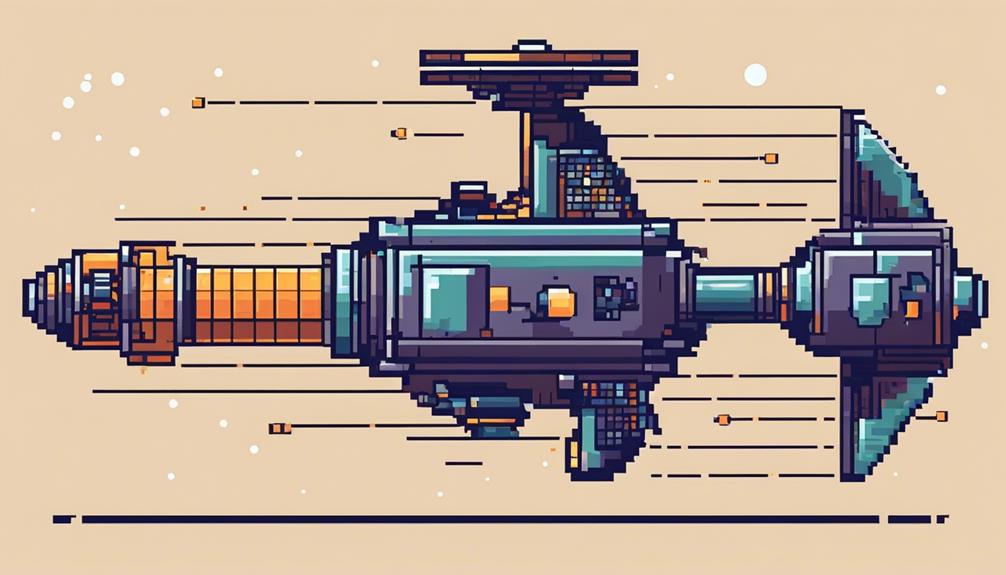The urgent need to address the growing issue of space debris has spurred a wave of innovation in satellite decommissioning and space clean-up initiatives. As orbital congestion escalates and the risk of collisions between active satellites and space junk intensifies, the development of advanced technologies and collaborative strategies has become paramount. With a myriad of promising projects and legislative measures underway, the realm of sustainable space management is evolving rapidly. The quest for effective solutions to ensure the long-term viability of space operations and safeguard against potential disruptions remains a compelling narrative in the realm of satellite decommissioning and space clean-up initiatives.
Key Takeaways
- Innovative technologies like GOLD system and CleanSpace One aid in satellite decommissioning and space clean-up.
- Advanced initiatives by RemoveDEBRIS and Astroscale focus on sustainable space debris removal.
- Satellite recycling programs and nanosatellites play a crucial role in space cleanup efforts.
- Policy frameworks and international collaboration are essential for effective satellite decommissioning and clean-up strategies.
Innovative Satellite Decommissioning Methods

Innovative satellite decommissioning methods play a crucial role in tackling the growing issue of space debris by utilizing advanced technologies to efficiently remove defunct satellites and other orbital debris. Various innovative solutions have been introduced to address the challenges posed by space debris and enhance space clean-up efforts. The GOLD system, for instance, employs ultra-thin balloons to increase drag on space debris, facilitating faster re-entry from years to months. This method significantly reduces the time debris spends in orbit, thus minimizing the risk of collisions with active satellites.
CleanSpace One represents another cutting-edge approach to satellite removal by using tentacles to capture and destroy space junk during re-entry, ensuring efficient and targeted clean-up of debris. The Ballistic Orbital Removal System takes a different approach, launching rockets filled with water to slow down orbiting junk, making it easier to remove from space. These methods showcase the diverse range of strategies being developed to address the pressing issue of space debris and enhance the sustainability of activities in Earth's orbit.
Laser Technology for Space Clean-Up
Laser Orbital Debris Removal (LODR) presents a cutting-edge approach to precision orbital cleanup. By harnessing high-powered pulsed lasers, LODR can effectively target and manipulate space debris, initiating controlled removal processes. This technology's cost-effectiveness and proven reliability over the past 15 years make it a promising solution for addressing the growing issue of space debris.
Laser Debris Removal
Utilizing high-powered pulsed lasers, the Laser Orbital Debris Removal (LODR) method efficiently creates plasma jets to target and remove space debris.
Emotive Numeric List:
- LODR contributes to space sustainability by actively clearing the orbital environment of hazardous debris.
- This innovative approach offers a cost-effective solution for space debris removal, with an estimated cost of $1 million per object.
- By slowing down space debris, LODR aids in facilitating their safe re-entry into the atmosphere or oceans.
- The use of existing laser technology in LODR showcases a promising method to reduce space junk and improve the overall cleanliness of space.
Precision Orbital Cleanup
Precision Orbital Cleanup employs advanced laser technology to effectively target and remove space debris cluttering Earth's orbit. Laser Orbital Debris Removal (LODR) utilizes high-powered pulsed lasers to generate plasma jets on the debris, altering its trajectory for controlled re-entry. This method, in practice for over 15 years, offers a cost-effective solution, estimated at $1 million per object. LODR's ability to slow down debris aids in guiding it towards safe re-entry points like the atmosphere or oceans. The technology's precision enables targeted removal, contributing to the mitigation of space debris concerns. The following table summarizes key aspects of LODR:
| Aspect | Details |
|---|---|
| Technology Used | High-powered pulsed lasers |
| Objective | Targeting and altering trajectories of debris |
| Cost per Object | Estimated at $1 million |
| Duration of Utilization | Over 15 years |
| Impact | Aids in controlled re-entry of space debris |
Advancements in Space Debris Removal

In the field of space debris removal, innovative technologies and methodologies are continuously being developed to effectively address the growing concern of orbital debris accumulation. Several advancements in space debris removal techniques have emerged to tackle this issue:
- The RemoveDEBRIS consortium is pioneering a capture mechanism that employs a net and harpoon to target objects up to 2 meters in diameter and weighing up to 2 tonnes, enhancing precision in space debris removal efforts.
- Astroscale's ELSA-d and ELSA-M programs showcase magnetic spacecraft capture systems designed to eliminate derelict satellites and reduce space debris, demonstrating a promising approach to cleaning up orbital space.
- Laser Orbital Debris Removal (LODR) introduces high-powered pulsed lasers to create plasma jets on space debris, enabling controlled re-entry into the atmosphere and mitigating the risks associated with debris collision.
- DARPA's Electrodynamic Debris Eliminator (EDDE) integrates 200 giant nets to scoop up space garbage for removal, strategically pushing objects into closer orbits for natural decay processes, highlighting an innovative solution to space debris management.
These developments underscore the ongoing efforts to enhance space debris removal capabilities, paving the way for a cleaner and safer orbital environment for future space missions.
Sustainable End-of-Life Satellite Solutions
Focusing on the sustainable management of end-of-life satellites, advanced technologies and protocols are implemented to facilitate the safe decommissioning of spacecraft and reduce the proliferation of space debris in orbit. Sustainable end-of-life solutions encompass various strategies aimed at mitigating the environmental impact of decommissioned satellites. Passive de-orbiting techniques, such as drag augmentation devices and terminator sails, enable satellites to gradually descend from orbit without the need for active propulsion systems, minimizing the risk of collision and fragmentation that can lead to space debris generation.
Design for demise principles play a crucial role in ensuring that spacecraft are designed to safely disintegrate upon re-entry into the Earth's atmosphere. By breaking up during the re-entry process, satellites can significantly reduce the amount of space junk that remains in orbit. Additionally, passivation procedures, which involve the venting of remaining propellants and discharging of batteries, are essential for preventing the scattering of debris that could pose hazards to operational spacecraft.
Novel Approaches to Space Junk Removal

Utilizing cutting-edge technology and innovative methodologies, various novel approaches have been developed for the effective removal of space junk cluttering Earth's orbit. These advanced methods offer promising solutions to mitigate the growing issue of orbital debris.
- Laser Orbital Debris Removal (LODR): By employing high-powered pulsed lasers, LODR creates plasma jets on space debris, enabling targeted propulsion for de-orbiting. Despite the estimated cost of $1 million per object, this precise technology shows great potential for cleaning up space junk efficiently.
- GOLD system: The GOLD system utilizes ultra-thin balloons filled with gas to enhance drag on space debris, significantly reducing the re-entry time from hundreds of years to mere months. This innovative approach accelerates the removal of defunct satellites and fragments from orbit.
- CleanSpace One: Developed by Swiss researchers, CleanSpace One is a compact satellite equipped with tentacles that capture space junk for disposal during re-entry through controlled heat and friction. This autonomous system demonstrates a proactive strategy in actively clearing debris from critical orbital paths.
- Ballistic Orbital Removal System: This system launches rockets containing water into space, creating a slowing wall that aids in gravitational pull, causing debris to fall out of orbit efficiently. The ballistic approach offers a unique and effective method to address the challenges posed by space debris accumulation.
These novel approaches showcase the potential for innovative technologies like Altius Space Machines' sticky boom robotic arm system to revolutionize space debris removal and ensure a sustainable and secure orbital environment for future space activities.
Cutting-Edge Space Clean-Up Initiatives
Building upon the innovative methodologies previously discussed, the current landscape of space clean-up initiatives showcases cutting-edge technologies and strategies aimed at efficiently removing orbital debris to maintain a secure orbital environment for future space endeavors. Several initiatives are at the forefront of space clean-up, each employing unique methods to tackle the growing issue of space debris.
| Initiative | Description |
|---|---|
| RemoveDEBRIS | Developing a capture mechanism using a net and harpoon, targeting objects up to 2 meters in diameter and 2 tonnes in weight. |
| Astroscale | COSMIC program focuses on designing a servicer to remove multiple satellites in one mission, aiding space debris removal efforts. |
| GOLD | Utilizes ultra-thin balloons inflated with gas to increase drag on space debris, accelerating re-entry from centuries to months. |
| CleanSpace One | Swiss satellite with tentacles designed to grab space junk and efficiently clean up debris during re-entry. |
| DARPA's EDDE | Features 200 giant nets to scoop up space garbage for removal, enhancing the safety of current satellites from potential debris impacts. |
These initiatives highlight the diverse approaches to space clean-up, from targeted capture mechanisms to innovative re-entry strategies, all contributing significantly to the ongoing efforts in satellite decommissioning and debris removal. By leveraging these advanced technologies, the space industry aims to mitigate the risks posed by orbital debris and ensure a sustainable orbital environment for future space activities.
Future of Satellite Recycling Technologies

The future of satellite recycling technologies holds promise for sustainable space cleanup initiatives. Innovative approaches, such as harvesting valuable components from defunct satellites in graveyard orbits using nanosatellites and robotic arms, are paving the way for cost-effective component extraction in space. These advancements not only enable more efficient space debris management but also contribute to the development of a more sustainable satellite industry.
Innovative Satellite Recycling
In the realm of satellite technology advancements, the future of satellite recycling technologies is centered on the extraction and repurposing of valuable components from decommissioned satellites. Innovative approaches include nanosatellites designed to extract components from satellites in graveyard orbits and advancements enabling efficient extraction. Satellites with harvesting capabilities can attach to retired satellites for recycling. Initiatives like DARPA's Phoenix program aim to promote sustainability and combat space debris accumulation.
- Nanosatellites revolutionize component extraction.
- Cutting-edge technology enhances efficiency.
- Harvesting satellites offer cost-effective solutions.
- Recycling initiatives drive sustainability efforts.
Sustainable Space Cleanup
With the increasing focus on sustainable space cleanup, the future of satellite recycling technologies is advancing towards innovative methods for efficient debris removal and component extraction, utilizing cutting-edge technologies such as nets, harpoons, and magnetic spacecraft capture systems. Space missions like the RemoveDEBRIS consortium and Astroscale's ELSA-d and ELSA-M programs demonstrate active debris removal and a plan for space sustainability. End-of-life services by Astroscale showcase demonstrations of recycling materials from defunct satellites. These initiatives, along with programs like DARPA's Phoenix mission and Altius Space Machines' sticky boom robotic arms, highlight the importance of developing advanced technologies for sustainable space cleanup.
| Space Mission | Technology Implemented | Focus Area |
|---|---|---|
| RemoveDEBRIS Consortium | Nets and Harpoons | Debris Capture & De-orbiting |
| Astroscale's ELSA-d & ELSA-M programs | Magnetic Spacecraft Capture Systems | Efficient Debris Removal |
| DARPA's Phoenix Program | Harvesting Components from Defunct Satellites | Valuable Component Extraction |
| Altius Space Machines | Sticky Boom Robotic Arm Systems | Attachment to Space Debris for Disposal |
Promising Space Debris Mitigation Strategies
Exploring innovative methods for mitigating space debris presents a critical challenge in ensuring sustainable orbital environments. Various promising strategies have emerged to tackle this issue effectively:
- Drag-Increasing Technologies: The utilization of drag-increasing technologies such as the GOLD system, which deploys ultra-thin balloons, accelerates the re-entry of space debris, ultimately reducing orbital clutter. This method offers a practical approach to managing defunct satellites and other debris items.
- Laser Orbital Debris Removal (LODR): LODR involves the use of high-powered pulsed lasers to generate plasma jets on space debris, enabling their controlled descent towards Earth. This cutting-edge technology shows promise in targeting and removing smaller debris pieces that pose a threat in orbit.
- Satellite-Based Debris Removal: Innovative satellite-based debris removal technologies like CleanSpace One employ tentacles to capture space junk and guide it safely back towards Earth for controlled destruction during re-entry. This method offers a hands-on approach to actively managing space debris.
- Water-Based Solutions: Solutions like the Ballistic Orbital Removal System use rockets filled with water to create a slowing wall, assisting space junk in falling out of orbit. This water-based approach provides a novel way to address the issue of orbital debris accumulation.
Emerging Concepts in Space Waste Management

The advancement of space waste management is witnessing the emergence of novel concepts aimed at revolutionizing the removal and control of orbital debris. Laser Orbital Debris Removal (LODR) employs high-powered pulsed lasers to create plasma jets on space debris, with an estimated cost of $1 million per object. Another innovative concept, the GOLD system, utilizes ultra-thin balloons inflated with gas to increase drag on space debris, significantly reducing re-entry time from centuries to months. CleanSpace One, a satellite developed by Swiss researchers, features tentacles designed to capture space junk and ensure their destruction during re-entry.
The Ballistic Orbital Removal System, proposed by James Hollopeter of GIT Satellite, involves releasing water from rockets to create a slowing wall that aids in removing orbiting junk from space. Energia's ambitious plan involves using a nuclear-powered space pod to knock defunct satellites out of orbit, with the goal of eliminating 600 dead satellites within a decade. These emerging concepts in space waste management demonstrate the innovative approaches being explored to address the growing issue of space debris and advance the field of satellite decommissioning and space clean-up.
Frequently Asked Questions
What Are the Initiatives for Space Debris?
Space sustainability initiatives encompass orbital collision prevention, debris mitigation, international cooperation, and future technology advancements. Efforts include legislation like the Orbital Sustainability Act, UK's Plan for Space Sustainability, and projects by ClearSpace UK and Astroscale Ltd for active debris removal. These endeavors aim to ensure the long-term viability of space operations, enhance safety, and foster innovation in managing the growing challenge of space debris.
What Is Being Done to Clean up Space?
Efforts to clean up space involve a multifaceted approach encompassing orbital recycling, sustainable practices, international collaboration, innovative technologies, and policy implementation. Organizations and initiatives are actively engaged in developing solutions such as capture mechanisms, magnetic spacecraft systems, and laser orbital debris removal. These initiatives aim to address the pressing issue of space debris accumulation and ensure the long-term sustainability of space activities.
What Is NASA Doing to Clean up Space Debris?
NASA is actively engaged in tackling the challenge of space debris through innovative technologies and strategic partnerships. The agency focuses on debris removal, international collaboration, and developing future solutions to ensure space sustainability. With a keen eye on the environmental impact of space junk, NASA emphasizes technological innovation to address orbital debris effectively. These efforts are crucial for safeguarding satellites and space missions from the risks posed by space debris.
How Are Satellites Decommissioned?
Satellites are decommissioned through various methods at the end of their operational lives. This process involves passivating propulsive and power systems to prevent debris generation. Satellite disposal tactics include deorbiting them to burn up in the Earth's atmosphere or moving them to designated 'graveyard orbits.' End-of-life procedures such as venting remaining propellant and discharging batteries are crucial for safe satellite retirement and orbital debris removal.

